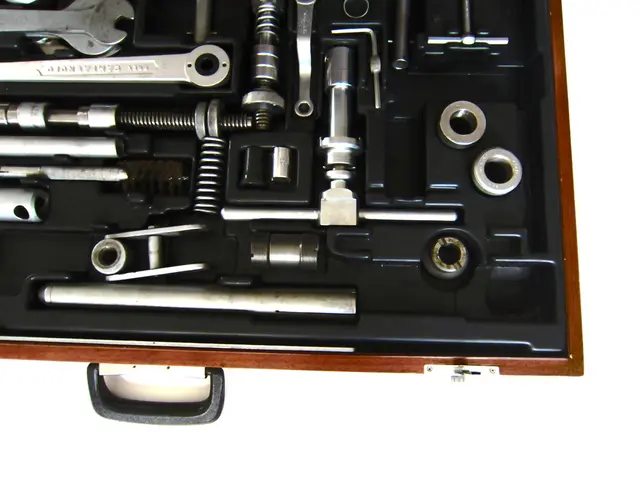Creative Math Strategies for Children: Combine Numbers with Enjoyable Techniques
Learning mathematics doesn't have to be a daunting task for children. In fact, incorporating fun addition tricks can make the process engaging, less stressful, and more enjoyable. These strategies, backed by recent educational insights, are effective in improving children's understanding and confidence in mathematics.
One such strategy is the use of concrete visual aids like blocks and number lines. These tools help children grasp the concept of addition by physically manipulating objects. For example, using base 10 blocks to represent numbers allows kids to see that addition means combining groups rather than just repeating numbers. This avoids common misconceptions and builds a foundational understanding of "togetherness" in addition[1].
Playful math tricks and patterns are another effective tool. Tricks designed around smart number patterns make math feel like a game, fostering a positive attitude and boosting children's speed and confidence when performing calculations[2]. Storytelling and relatable contexts, such as framing addition as "You have 2 apples, your friend gives you 3 more," not only teaches the math operation but also its practical significance, deepening comprehension[3].
Pattern recognition, puzzles, and games engage children’s spatial reasoning, memory, and number sense—all important for mental math proficiency. Activities such as tangrams, LEGO sorting, and jigsaw puzzles integrate math skills naturally and encourage logical thinking[3][4].
Play-based, hands-on learning with the right toys reduces math anxiety and makes the process enjoyable. Tools like pattern blocks, math cubes, and geoboards help children visualize addition and other concepts concretely, reinforcing learning through multiple sensory channels[5].
Combining digital tools with physical activities enhances engagement and understanding. Interactive apps paired with real-world manipulative exercises create a multi-sensory learning environment, which is effective for building long-term mathematical skills[5].
Addition tricks are tools that boost student confidence by making it easier to solve sums correctly. Methods such as counting on fingers, starting with the bigger number and counting up to the smaller one, or using a number line to jump forward a certain number of spaces can help solve addition problems[6].
Other useful tricks include skip counting, a method used for repeated addition and can also serve as a trick for multiplication[7]. The doubles trick, where children learn that 1 + 1 = 2, 2 + 2 = 4, 5 + 5 = 10, and can solve near doubles like 5 + 6 = 5 + 5 + 1 = 11, is a simple yet effective tool for mental math[8].
Breaking numbers that add up to or near 10 into tens can simplify the addition process. For instance, when adding 7 + 3, children can break it down into 7 + 10 - 3 = 10 - 3 = 7. Similarly, breaking big numbers into tens and ones can make the addition process easier to manage[9].
Kids can use flashcards for practice, and adding zero to a number keeps the number unchanged, a property known as the identity property of addition[10]. Turning math into a board game can make it fun, and using objects like blocks, buttons, or toys can make the addition process more accessible for children[11].
In summary, fun addition tricks effectively improve children’s math understanding by making learning interactive, concrete, and enjoyable. This not only supports conceptual grasp but also builds confidence and fosters a positive attitude towards mathematics from an early age[1][2][3][5].
[1] https://www.edutopia.org/blog/base-10-blocks-math-instruction [2] https://www.nctm.org/Publications/Teaching-Children-Mathematics/ [3] https://www.edutopia.org/blog/storytelling-mathematics-instruction [4] https://www.nctm.org/Publications/Mathematics-Teaching-in-Motion/ [5] https://www.ncbi.nlm.nih.gov/pmc/articles/PMC5740852/ [6] https://www.khanacademy.org/math/elementary-school-math/k-3-math/kindergarten-math/a/how-to-add-using-counting-on [7] https://www.khanacademy.org/math/elementary-school-math/k-3-math/kindergarten-math/a/skip-counting [8] https://www.khanacademy.org/math/elementary-school-math/k-3-math/kindergarten-math/a/doubles-trick [9] https://www.khanacademy.org/math/elementary-school-math/k-3-math/kindergarten-math/a/composing-and-decomposing-numbers [10] https://www.khanacademy.org/math/elementary-school-math/k-3-math/kindergarten-math/a/identity-property-of-addition [11] https://www.education.com/activity/article/Addition-Games-for-Kids/
Engaging in hands-on learning activities, such as using concrete visual aids like blocks and number lines, can be a powerful tool for children's understanding of addition and learning. Immersing in playful math tricks and patterns, such as smart number games, also helps foster a positive attitude toward mathematics, facilitating speed and confidence in calculations.




